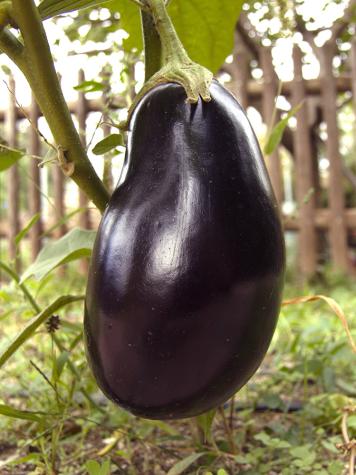GALLATIN, Mo. – Eggplant is one of those vegetables that you either love or hate. If you fall under the “love it” category, this high-yielding summer plant can be a great addition to the home garden.
Eggplant belongs to the nightshade family, which also includes tomatoes, peppers and potatoes. Native to Asia, it has been cultivated in China for at least 1,500 years. It wasn’t until around the 14th century that eggplant made its way into Italy, a country long associated with eggplant, as in eggplant Parmesan.
“Eggplants were once considered less than desirable as food, sometimes even considered poisonous,” says Tim Baker, University of Missouri Extension horticulturist. “In the 16th century it was known as the mad apple because it was thought that consumption would lead to insanity.”
Baker said the name eggplant comes from the shape of small-fruited varieties, which were similar in size and shape to eggs. France and a number of other European countries call it an aubergine.
Growing eggplant
Eggplants love the heat of summer.
“Like tomatoes, eggplants love hot weather and do their best in midsummer,” Baker said. “Daytime temperatures of 75 to 80 degrees are optimal. Nighttime temperatures are best above 68 degrees.”
Even though they thrive on heat, eggplant are not drought tolerant, so make sure they get plenty of water during the hot weather, he said.
You’ll have your best success with eggplant if you choose disease-resistant varieties, Baker said.
Some of the diseases that are problems in tomatoes, such as verticillium wilt, also attack eggplants. “Rotating the crop each year will lesson the likelihood of disease,” he said.
Flea beetles can be a big problem for eggplant. These small, black beetles, about 1/16 of an inch long, feed on the leaves, making many small holes. Baker said even if a flea beetle attack doesn’t kill the plant it could stunt growth and reduce yields.
“If flea beetles are a problem, you will need to maintain a regular spray schedule in order to harvest a crop,” he said.
Harvesting
According to Baker, the best time to harvest eggplant is when they’re young, about 1/3 to 2/3 of their mature size.
“If you press lightly on the side of the eggplant with your thumb, the flesh should readily spring back. If it doesn’t, the fruit is too mature,” Baker said.
Skin color is also an indication of fruit maturity, he said. The fruit is at its best when it has a high gloss, but overmature eggplant may look dull with possible bronzing.
You should be able to harvest eggplant two to three times a week during peak growth, which means you’ll have plenty to share with neighbors and friends.
For more information, see the MU Extension guide “Eggplant Production” (G6369), available for free download at extension.missouri.edu/g6369. You can also find information on recommended varieties and how and when to plant in MU Extension’s Vegetable Planting Calendar (G6201).
Tips for preparing eggplant
If you don’t like eggplant’s bitter taste, there’s an easy fix. Sprinkle salt over sliced or cubed eggplant and set it aside for about 30 minutes. The salt will draw out the bitterness. Then you just need to rinse the eggplant to remove the salt and it’s ready to add to soups, stews and other recipes.
The beauty of eggplant is its ability to absorb other flavors. When choosing flavor combinations, remember that sweet, salty and tangy are flavors that complement eggplant nicely.

